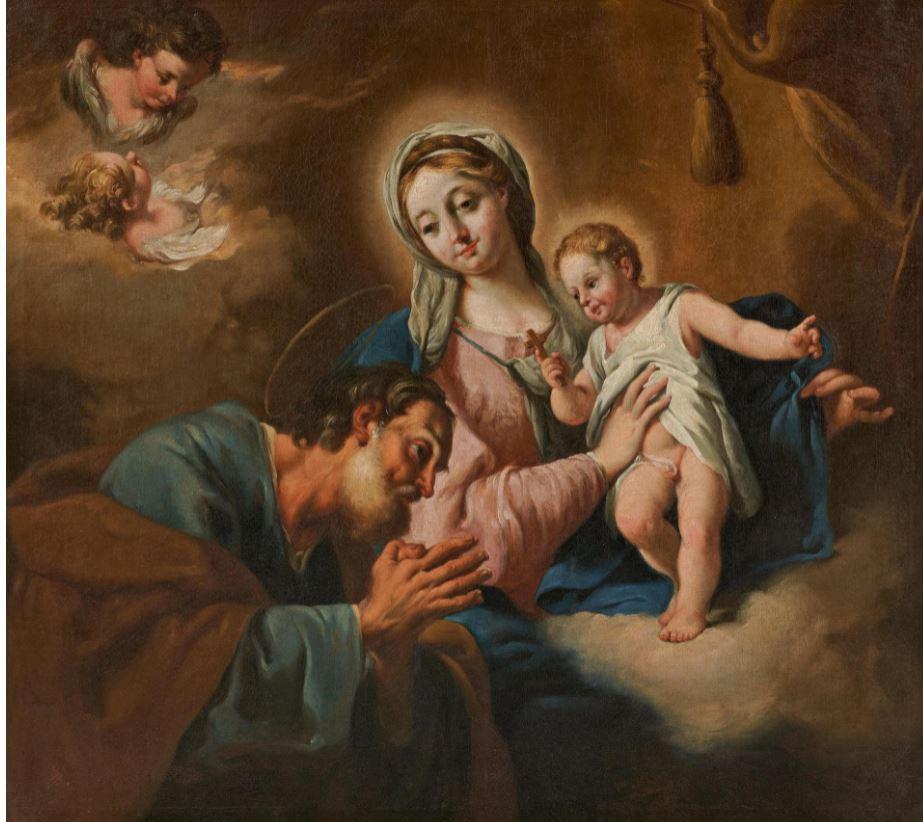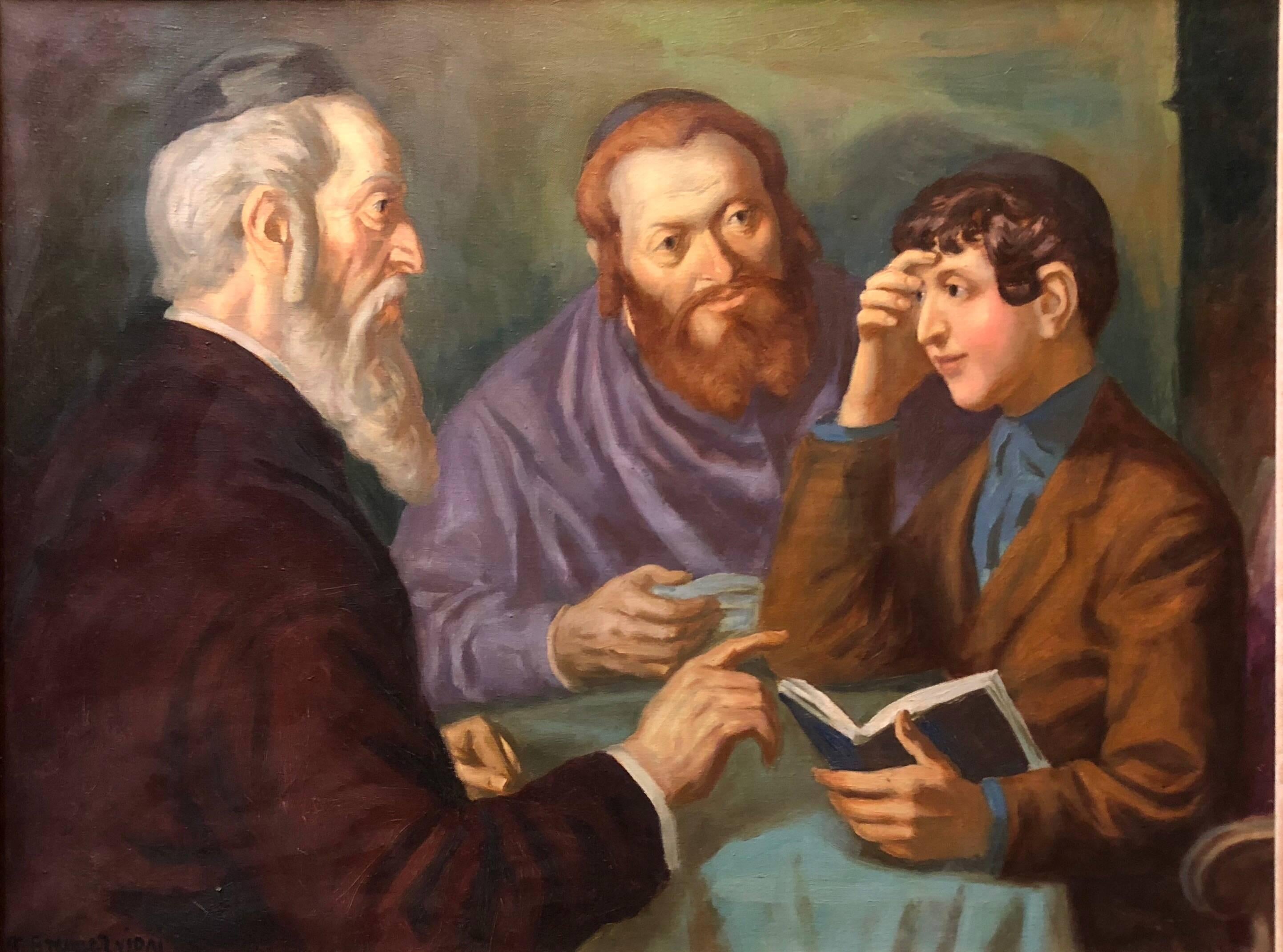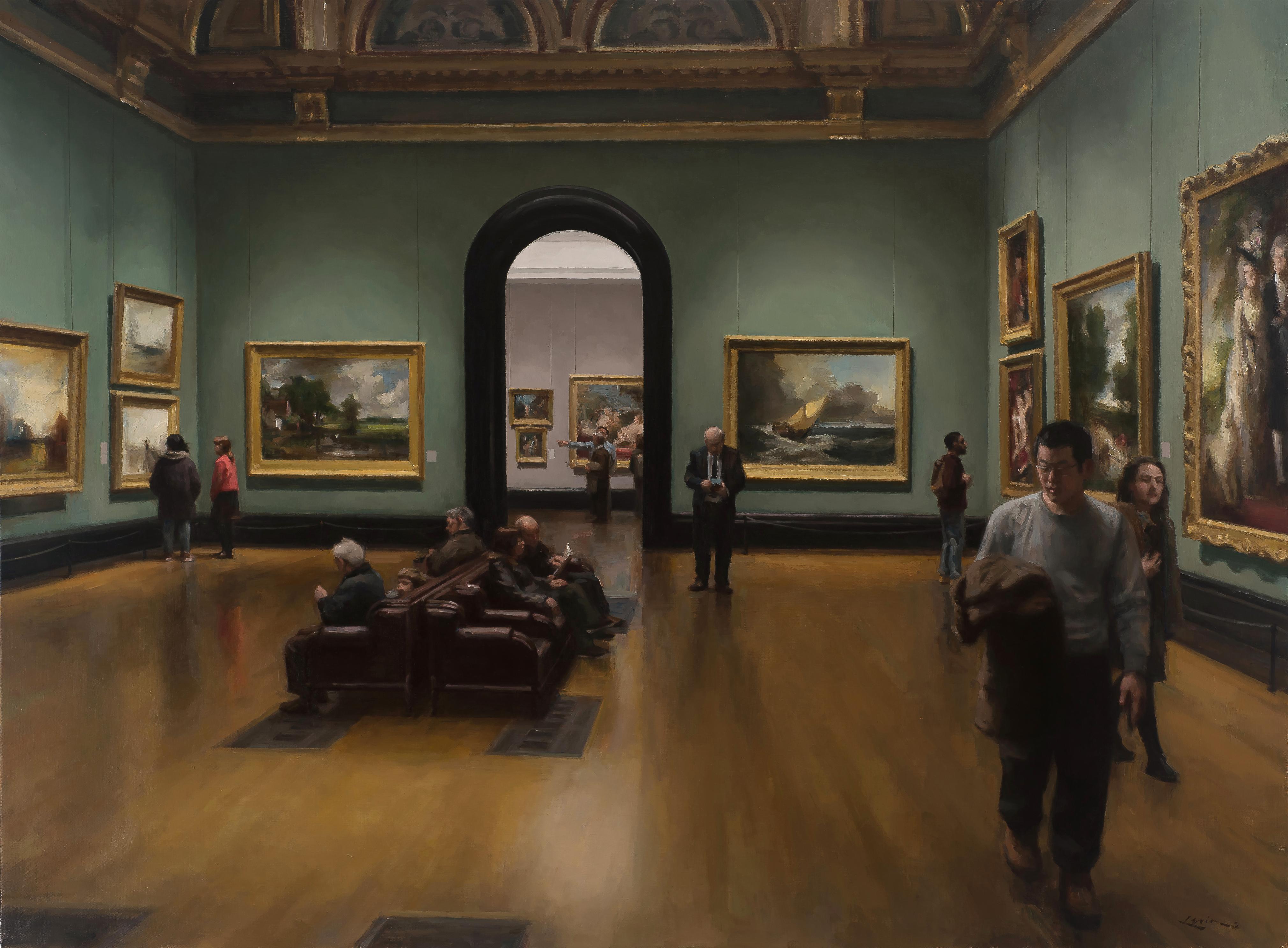Items Similar to Daily Life Scene in a 17th Century Vermeer Style - Dutch Oil Painting on Canvas
Want more images or videos?
Request additional images or videos from the seller
1 of 9
UnknownDaily Life Scene in a 17th Century Vermeer Style - Dutch Oil Painting on Canvas 1948
1948
About the Item
This tribute painting to Flemish art by an unknown artist portrays figures inside a mansion with a yellow and black checkerboard floor and a stained-glass window with brilliant colors as a backdrop. It definitely reminds the viewers of Vermeer's universe.
The three characters include two knights holding a drink and a woman, likely the wife of one of them. In this painting, the use of a meticulous technique to render human figures and apparel provides the setting for depicting a domestic bourgeois event. But the artwork goes beyond simply presenting a scene from daily life. What sets this painting apart is its use of light and shadow to capture every intricate detail. The characteristic play of velvety textures and light reflects the region's specific weather. The diffuse light coming from the overcast sky, shining through the right window, lends the room a subtly subdued ambiance. It definitely reminds us of the quality of the light found in the Flanders or even in the Picardy or Artois regions.
Flemish art is internationally renowned for its vivid depictions of narrative scenes and unsurpassed technical skills. It often features heroes and chivalric themes, with athletic men and radiant women, portrayed as fresh and spontaneous, yet lacking in grace and distinction. Vibrant, flowing fabrics serve as a framework to activate the striking effect of oil pigments on clothes.
This painting sits in a beautiful custom-made frame. It is signed and dated (1948) by the artist on a parchment paper half dangling from the table, near a vase on which the painter wrote a Dutch saying: "Melck is goed voor Elck" which can be translated by "Milk is good for everyman".
- Creation Year:1948
- Dimensions:Height: 38.5 in (97.79 cm)Width: 64 in (162.56 cm)Depth: 3 in (7.62 cm)
- Medium:
- Movement & Style:
- Period:
- Condition:The paint has tiny cracks, like many of these old paintings, which is typical of the patina of this type of artwork.
- Gallery Location:Pasadena, CA
- Reference Number:1stDibs: LU654312274602
About the Seller
5.0
Vetted Seller
These experienced sellers undergo a comprehensive evaluation by our team of in-house experts.
Established in 1999
1stDibs seller since 2017
51 sales on 1stDibs
Typical response time: 21 hours
- ShippingRetrieving quote...Ships From: Pasadena, CA
- Return PolicyA return for this item may be initiated within 3 days of delivery.
More From This SellerView All
- Contemporary Acrylic Abstract Painting by Mitchell WrightLocated in Pasadena, CAThis blue monochrome painting by contemporary artist Mitchel Wright transports us to distant worlds beyond our comprehension. Within his seemingly infinite networks of lines, dots, and crosses, he decodes the recognizable to create something unfamiliar. Wright crosses shades of blue and grey lines, reconstructing a sense of regularity obtained by the arrangement of different triangles sizes. The triangular forms used for the painting contrast with the perfect square shape of the artwork. It sits in a grey metal frame. Mitchell Wright...Category
Late 20th Century Contemporary Abstract Paintings
MaterialsCanvas, Acrylic
- "My Two Windows" Oil Painting on Canvas by Wesley JohnsonBy Wesley JohnsonLocated in Pasadena, CAIn this composition, Californian artist Wesley Johnson invites us to contemplative stillness. The abstract essence of this work flourishes into a living entity, enriched by a blend o...Category
Mid-20th Century Abstract Expressionist Abstract Paintings
MaterialsOil
- "Dining Room " Monochromatic Interior Scene in Sepia Tones by Geoffrey JohnsonBy Geoffrey JohnsonLocated in Pasadena, CASepia tones permeate this remarkable oil painting by American artist Geoffrey Johnson, who captures a hauntingly timeless scene. A woman waits by the window of her home, silent, almost absorbed in the diffuse ambiance of the room? The artist emphasizes the intimacy of his subject, a silhouette between presence and absence whose identity he has limited to a shadow. The woman is treated like a ghost, associating her with the invisible and the forgotten. In all its diversity, art is a step towards understanding human emotions and, often, an opening into the soul. The canvas analyzed here is that of a seemingly banal dining room, including an old-style kitchen area, inhabited by this quasi-incorporeal female figure. This eloquent artistic choice echos a reflection on the condition of loneliness. Few details appear some paintings on the wall, a dining table with two visible plates, a chandelier, etc. The sepia tint is emblematic of nostalgia, reminiscent of the photographic process that ages pictures to give them an air of yesteryear. Here, the artist recalls the past, not to idolize it, but to question the persistence of female alienation over time. The deliberate use of a restricted, even desaturated chromatic range reflects a timeless universe in which the female figure echoes across the ages. Like an entity in a sepia photograph, where the being is frozen for eternity, the woman appears and disappears simultaneously, symbolizing the volatility of existence and the fragility of memory. Johnson confronts us with a profound reflection on our solitude and relationship with time, painting the isolation of women in the hues of a bygone era. Through a technique that magnifies the essential and erases the extra, he resurrects an atmosphere inviting us to reinterpret our reflection on existence. -------------------------------------------------------------------- Born in 1965 in Greensboro, North Carolina, Geoffrey Johnson graduated from the Pennsylvania Academy of Fine Arts, where he received several awards and prizes for his artistic excellence. Since 1995, he has exhibited in galleries and venues throughout the United States. His paintings may be found in many private and corporate collections, including those of Coca-Cola, Turner Broadcasting, BellSouth, and Wells Fargo. Johnson draws much of his inspiration from his travel experiences and first-hand observations. Using a monochromatic palette of sepia hues, the artist strives to reproduce the places that inspire him. Johnson’s work is powerfully evocative of the French Impressionists’ depictions of city life, interior spaces, and equestrian scenes. From Gustave Caillebotte’s steely, atmospheric renderings of foggy Paris streets and dusky rooftops to Degas’ spindly-legged racehorses, the influence of these artists upon Johnson’s painting is readily visible. His manner of distorting the human figure has also been likened to the skeletal, surreal forms of Alberto Giacometti. Johnson has established himself as a true innovator, successfully capturing the alluring space between abstraction and realism. His work is significantly influenced by his fascination with both the human figure and the powerful architecture of a modern city. Through a feeling of anonymity, figures become suggestive shapes, and the skyline of New York materializes mysteriously in the background. Johnson’s paintings embody the mood of each urban experience. Johnson has “always been attracted to interiors, work spaces [and] personal spaces.” Inspired by a box of...Category
21st Century and Contemporary Interior Paintings
MaterialsOil
- "Hope : Between Earth and Heaven" Surrealist Acrylic on Canvas by Eugene HawkinsLocated in Pasadena, CAIn the "Fantasy/Metaphysical" series by American artist Eugene Hawkins, the convergence of surrealism and metaphysics unfolds as an exploration of existential themes common to all. C...Category
1960s Surrealist Figurative Paintings
MaterialsCanvas, Oil
- Still-Life Blue Tones Oil on Canvas by Edward SotelloLocated in Pasadena, CAWith this oil painting realized by the Californian artist Edward Sotello, we can clearly see on the right a glass, a vase, and some flowers placed on a table. On the left, a possible...Category
Mid-20th Century Expressionist Still-life Paintings
MaterialsOil, Canvas
- " Tricycle and Doll" Oil on Canvas by Edgar KiechleLocated in Pasadena, CAThis figurative painting by Edgard Kiechle presents the scenario of a doll who is very surprised to have been abandoned into the basket of her mom's tricycle. An interesting factor is the pictorial use of angles. The point of view, a little above the stage, probably that of an adult, offers particular perspectives. This approach adds depth to this painting with distinctive compositional appeal. In contrast to the scene's disorder, a black-and-white tiled floor with a geometric design serves as an antithesis. The careful symmetry of the tiles competing with the surrounding disarray sparks a dialogue about the human need for organization and balance. In composition, absence is a living element. The exclusion of a physical human figure amplifies the feeling of emptiness, creating a human presence perceived imaginatively. Edgar O. Kiechle was born in 1911. He was a film illustrator and a painter. Edgar studied landscape painting with Jean Mannheim and architecture and became an excellent watercolorist. After studying at the Otis Art Institute in Los Angeles, he interned with leading architects and designers. He worked at most major studios, but his career as an illustrator saw him primarily at the Universal Studio Art department. In 1933, Edgar joined Lwerks as a background artist and worked on many films produced by Animated Picture Corporation through 1935. In the summer of 1941, Edgar Kiechle...Category
Mid-20th Century Figurative Paintings
MaterialsOil, Canvas
You May Also Like
- Two young women conversing in the kitchen, original oil on canvas, circa 1920By Edward Antoon PortieljeLocated in Nutfield, SurreyThis beautiful oil on canvas painting of two women conversing in the kitchen is circa 1920 and is by the artist Edward Antoon Portielje (1861, Antwerp - 1949) who was a Belgian genre painter. He was born to the painter, Jan Portielje...Category
1920s Flemish School Figurative Paintings
MaterialsOil, Canvas
- Floral Still Life Country Flowers in a Vase by Flemish Barbizon artist in FranceLocated in Norwich, GBA gorgeous floral still life which marries the depth and the richness found in the work of the Flemish old masters with the elegance and light of French painting. As you will see, th...Category
1880s Flemish School Interior Paintings
MaterialsPanel, Oil
- Giovanni Battista Pittoni, Holy Family with Cupids, Venetian Baroque, ChristmasBy Giovanni Battista PittoniLocated in Greven, DEIn 2001 the German art historian Art historian and Raphael Expert, Prof. Jürg Meyer zur Capellen, published the painting "Die Heilige Familie" in a monographic article, ascribing the present work to the Venetian painter Giovanni Battista Pittoni (1687 -Venice - 1767). (Newspaper "Weltkunst", October 2001, No 12, p. 1850 f. ill.) He describes it as a typical work by this artist. Pittoni was one of the most influential and successful artists of the Venetian Settecento. He was a pupil of the Veronese Master Giovanni Balestra (1666-1740). His style is influenced by Sebastiano Ricci (1659-1734) and Giambattista Tiepolo (1696-1770). Giovanni Battista Pittoni was already successful at a young age and soon lead his own workshop. He created large-scale hitoria paintings, as well as large, religious altarpieces. In addition to Venetian and Upper Italian patrons, Pittoni also had many interested parties from Europe. His work is accordingly scattered in many different museums and private collections today. Pittoni - like other painter colleagues of his time - repeated his own compositions both by hand and with the help of his workshop. He repeatedly incorporated details into other pictures and contexts. Prof. Meyer zur Capellen noted the very good condition of the present work and the high quality of the paint with fine graduations and the vivid brushstrokes. Provenance: The panting has not been on the art market for at least 300 years. In the year 2000 the work was donated by the Münster-based, Noble Family Ketteler zu Harkotten to a private collection in Westphalia. Most probably the canon Nikolaus Hermann von Ketteler zu Harkotten bought the piece in Venice in 1750 together with the altarpiece of the Clemens Church in Münster. On the reverse of the work is a fideicommissum number by Ketteler zu Harkotten. As it belonged to the family commission, the painting was inalienable until 1919, when the corresponding law was repealed, and after that time it remained in the family's possession without interruption. Pittoni's only direct relationship to Münster is the commission for the high altar painting of the Baroque St. Clemens Church. It can be assumed that then canon von Ketteler saw this painting in the artist's workshop during his stay in Venice and acquired it for himself. This would also explain the discrepancy in dating. (ca. 1735/1750). However, it is also possible that the painting originated in the possession of Ferdinand von Plettenberg...Category
Early 18th Century Rococo Figurative Paintings
MaterialsCanvas, Oil
- Early 20th century French oil, seated ballerina adjusting her ballet slipper.Located in Woodbury, CTVery Impressive French Impressionist figure study of a Ballerina seated in an interior. A very decorative and very desirable oil on canvas dating from the early 1900's The painting...Category
Early 1900s Impressionist Figurative Paintings
MaterialsCanvas, Oil
- the Rabbi's Cheder Test Hungarian Judaica Oil PaintingBy Nandor Vydai BrennerLocated in Surfside, FLRare Pre World War II (Pre Holocaust) Judaica Art. European Judaic art from this period is exceedingly rare. Nandor Brenner Viday, Born in Budapest, Hungary in 1903, date of death u...Category
Early 20th Century Post-Impressionist Figurative Paintings
MaterialsCanvas, Oil
- National Gallery, London - museum interior, London, paintings by Turner and moreBy Steven J. LevinLocated in Sag Harbor, NYAn oil painting of the interior of The National Gallery museum in London. A multi-figure composition, of people inside a grand room filled with some of the world's most famous paintings, including John Constable's 1821 painting "The Hay Wain", and J.M.W. Turner's moody 1801 painting "Dutch Boats...Category
21st Century and Contemporary American Realist Interior Paintings
MaterialsOil, Canvas
Recently Viewed
View AllMore Ways To Browse
Vintage Daily
Dutch Oil On Canvas
Dutch Oil On Canvas Painting
Dutch School Oil Paintings
17th Style Painting
Vermeer Paintings
Dutch Painting 17th
Dutch Painting 17th Century
Mansion Painting
Drinking Scene
Vintage Dutch Oil Paintings
17th Dutch Oil
Dutch Oil Paintings 17th Century
Milk Painting
17th Century Fabric
17th Century Flemish Painting
17th Century Dutch Style
Vintage Dutch Scenes


